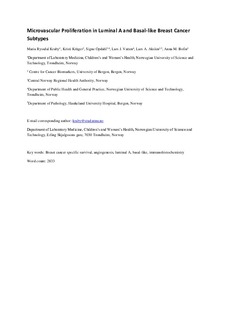| dc.contributor.author | Kraby, Maria Ryssdal | |
| dc.contributor.author | Krüger, Kristi | |
| dc.contributor.author | Opdahl, Signe | |
| dc.contributor.author | Vatten, Lars Johan | |
| dc.contributor.author | Akslen, Lars A. | |
| dc.contributor.author | Bofin, Anna M. | |
| dc.date.accessioned | 2019-01-21T12:21:59Z | |
| dc.date.available | 2019-01-21T12:21:59Z | |
| dc.date.created | 2015-10-08T15:03:19Z | |
| dc.date.issued | 2015 | |
| dc.identifier.citation | Journal of Clinical Pathology. 2015, 68 (11), 891-897. | nb_NO |
| dc.identifier.issn | 0021-9746 | |
| dc.identifier.uri | http://hdl.handle.net/11250/2581517 | |
| dc.description.abstract | Aims The aims of this study were to examine microvessel density (MVD), proliferating MVD (pMVD) and Vascular Proliferation Index (VPI) in basal-like phenotype (BP) and luminal A subtypes of breast cancer and to study their prognostic value.
Methods Dual-colour immunohistochemistry for von Willebrand factor and Ki67 was done on sections from 62 luminal A and 62 BP tumours matched for grade and selected from 909 breast cancers previously reclassified into molecular subtypes. Associations between MVD, pMVD and VPI, molecular subtypes and breast cancer prognosis were estimated using linear regression and survival analyses.
Results Both pMVD (difference 1.9 microvessels/mm2 (p=0.002)) and VPI (difference 1.7 percentage points (p=0.014)) were higher in BP tumours compared with luminal A. No clear difference between subtypes was found for MVD. However, only MVD was associated with prognosis. HR for breast cancer death for all cases was 1.10 (95% CI 1.02 to 1.18) per 10 vessels increase. Among luminal A tumours, HR was 1.22 per 10 vessels increase (p<0.001) and in BP it was 1.04 (p=0.37).
Conclusions High MVD was associated with poor prognosis in luminal A, but not in BP cancers. Vascular proliferation was higher in BP, indicating a more active angiogenesis than in luminal A tumours. The luminal A subgroup comprised mostly histopathological grade 3 cancers in this selected series, and further studies are needed to clarify whether MVD provides additional prognostic information for luminal A tumours irrespective of grade. This may contribute to stratification of this large group of patients and may aid in identifying tumours with a particularly good prognosis. | nb_NO |
| dc.language.iso | eng | nb_NO |
| dc.publisher | BMJ Publishing Group | nb_NO |
| dc.title | Microvascular proliferation in luminal A and basal-like breast cancer subtypes | nb_NO |
| dc.type | Journal article | nb_NO |
| dc.type | Peer reviewed | nb_NO |
| dc.description.version | acceptedVersion | nb_NO |
| dc.source.pagenumber | 891-897 | nb_NO |
| dc.source.volume | 68 | nb_NO |
| dc.source.journal | Journal of Clinical Pathology | nb_NO |
| dc.source.issue | 11 | nb_NO |
| dc.identifier.doi | 10.1136/jclinpath-2015-203037 | |
| dc.identifier.cristin | 1279339 | |
| dc.relation.project | Norges forskningsråd: 223250 | nb_NO |
| dc.relation.project | Norges forskningsråd: 191778 | nb_NO |
| dc.description.localcode | © 2015. This is the authors' accepted and refereed manuscript to the article. The final authenticated version is available online at: http://dx.doi.org/10.1136/jclinpath-2015-203037 | nb_NO |
| cristin.unitcode | 194,65,15,0 | |
| cristin.unitcode | 194,65,20,0 | |
| cristin.unitname | Institutt for klinisk og molekylær medisin | |
| cristin.unitname | Institutt for samfunnsmedisin og sykepleie | |
| cristin.ispublished | true | |
| cristin.fulltext | postprint | |
| cristin.qualitycode | 1 | |
